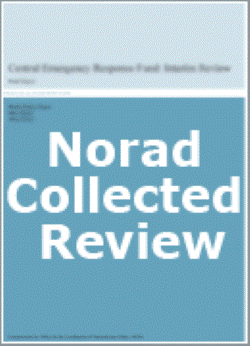Mid-Term Review of the SANTED II Program of Support to Tertiary Education in South Africa
Om publikasjonen
- Utgitt: oktober 2009
- Serie: Norad-innsamlede rapporter
- Type: --
- Utført av: Robert Smith, LINS and Michael Cross, University of the Witwatersrand South Africa
- Bestilt av: Royal Norwegian Embassy, Pretoria
- Land: Sør-Afrika
- Tema: Utdanning og forskning
- Antall sider: 70
- Serienummer: 10/2009
- ISBN: 978-82-7548-437-4
- ISSN: --
- Prosjektnummer: RSA-04/008

The Project
South Africa-Norway Tertiary Education Program (SANTED) II (2006-2010) is a continuation of a program started in 2000, supporting the transformation process in the tertiary education sector in South Africa, building on its principles and experience. Three main areas are focused: improvements in student access; retention and success, capacity building among university managers; development of regional (SADC) cooperation among selected universities. SANTED II involved 16 projects in 6 partner countries.
Interesting Findings
• The Reviewers found that the management of the program had been excellent and that partner organizations had appreciated the level of support available; some financial disbursement problems had been experienced but these had largely been overcome by new procedures.
• Access, retention and success activities had generally been successful in the institutions visited especially as a variety of approaches had been taken. SANTED has created environments where student tracking and support systems were seen as core activities for universities; staff buy-in remained problematic in some instances.
• Capacity building was demonstrated at numerous levels from the induction of staff into more IT-related practices to the skill and knowledge development of student peer-educators. Reflection on university practice at the curriculum and program design level as well as at the ‘forms of knowledge’ level was a significant contribution by SANTED to capacity building in this crucial sector of the education system. Further examples of capacity building have been demonstrated at UNAM with its new Faculty of Engineering, Rhodes’ reinvigoration of its African Language Studies, the Virtual Classroom project and the HIV/AIDS Peer Educator work.
• Regional cooperation has worked best where there has been a common academic culture and where partners have shared a certain level of administrative competence; the quality of initial analysis before partnerships are signed up to is a critical issue for later success. Partnerships built on successful prior experience also stand a better chance of achieving their goals.
• Individual components performed well and were efficiently managed; monitoring and evaluation procedures were institutionalized and provided reliable feedback.
• Sustainability has largely been established with examples of universities taking on SANTED-funded staff and activities within their own budgets.
• Problems remain in terms of the extent to which individual universities may be able to take up financial responsibility for SANTED activities beyond the program’s termination, the extent to which staff have been able to ‘buy-in’ to new practices, the limited amount of strategic research undertaken within SANTED and the continuing problem of staff overload in some institutions. IT problems are not fully overcome and there are still some imbalances in partnerships arrangements.
• However, the total picture of SANTED II has been a very positive one and the reviewers predict that its final stages will run smoothly and will leave a lasting legacy for South African tertiary education.
